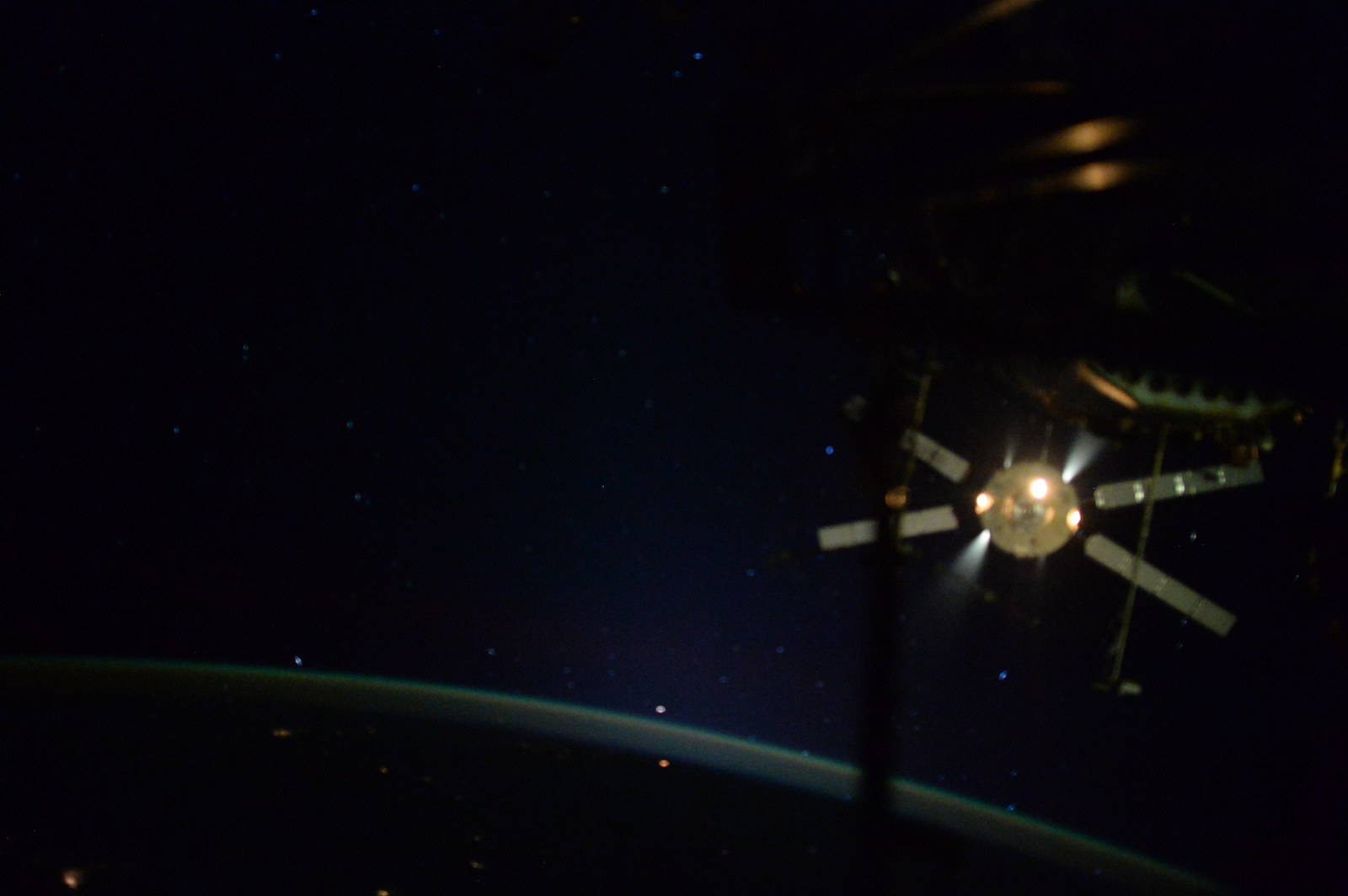Farewell, Georges Lemaître – ATV burns up during re-entry

The final farewell; Georges Lemaître, the fifth and last European Automated Transfer Vehicle (ATV) performed a controlled re-entry into Earth’s atmosphere and burned up at around 19:00 CET on 15 February. Its task had been to transport supplies and experiments to the International Space Station (ISS) and to raise and adjust the International Space Station ISS orbit. The era of ATV space transporters has now drawn to a close with its retirement from service – but the expertise gained during their development and operation will live on as part of the European service module fitted to the United States Orion space capsule.
A fiery finale in a tumbling descent
One day earlier, at 14:45 CET on 14 February, ATV-5 undocked from the Space Station’s Russian Zvezda module and set course for Earth. Before re-entry, two precision braking manoeuvres caused the 20-ton transporter to plunge into Earth’s atmosphere at a steep angle, ensuring that it disintegrated and burned up as intended. The thrusters were also fired, causing the vehicle to tumble in flight and helping the ATV break up into small pieces. Three re-entry experiments recorded data during the manoeuvre, including the temperature profile, transmitting the information back to the ground. One of these experiments was the Reentry Break up Recorder – a kind of ‘black box’ that records mechanical loads and that has already been used in previous de-orbitings. This time, it was fitted with two cameras operating in the optical and infrared range, transmitting images from the start of re-entry until ATV disintegration.
Safety concerns meant that the European Space Agency’s (ESA) plans to initiate a ‘shallow re-entry’, meaning a return to Earth’s atmosphere at a less steep angle, had to be abandoned. A battery failed in one of the four redundant power supply chains just a few days ago.
LIRIS improves automatic docking
The ATV-5 took off from Europe’s spaceport in French Guyana on 30 July 2014 atop an Ariane 5 launcher. The vehicle carried supplies of water, propellants, air and food, along with the Electromagnetic Levitator (EML) and the German experiments MagVector, Spacetex and WiseNet. Before docking with the Space Station under the watchful eyes of ESA astronaut Alexander Gerst and cosmonaut Alexander Skvortsov on 12 August 2014, the ATV’s new rendezvous sensors – Laser InfraRed Imaging Sensors (LIRIS) – underwent tests. The system is an upgraded combination of laser and infrared technology, and is designed to enable and optimise robotic applications such as the disposal of space debris.
The crew set about unloading the transporter immediately after the docking procedure. The largest experiment, weighing over 300 kilograms, was EML. Gerst installed the system in the Columbus laboratory and initiated test sequences. The furnace melts and analyses metal alloys in a freely suspended state. It will be used over the coming months to conduct experiments on 18 different metal samples. EML delivers highly precise data that may produce significant advances in the simulation of casting processes used in metalworking.
ATV has passed – long live Orion
The demise of Georges Lemaître means the final ATV is irretrievably lost – but its technology will live on as part of the European Service Module (ESM), which will form part of the US Orion space capsule. ESM will be responsible for the spacecraft’s energy supply, propulsion and thermal control, as well as storing supplies. The service module is a barter element, which means it secures European rights to use the ISS from 2017 to 2020.
Orion will undergo unmanned testing during 2018, and will initially explore the Moon. Subsequent missions will take the capsule further afield – to objects in more remote areas of space, including asteroids. With the ESM, ESA has, for the first time, been responsible for developing such a highly complex and critical component within an important US mission – a huge vote of confidence that would not have been possible without the successful ATV programme. Like ATV, ESM will be developed and built by Airbus Defence and Space in Bremen.
The end of an era
Completing five successful flights, the ATV achieved more than simply fulfilling the expectations for the programme: the European space transporter performed all fully automated flight and docking manoeuvres with unprecedented precision. Pinpoint accurate arrivals at the ISS while travelling at a speed of 28,000 kilometres per hour were strokes of technical mastery. Additionally, ATV is the largest and most complex spacecraft ever used for transport purposes. The first space transporter, Jules Verne, set off for the Space Station in 2008, followed by Johannes Kepler (2011), Edoardo Amaldi (2012), Albert Einstein (2013) and Georges Lemaître (2014). In total, the five flights carried approximately 32 tons of freight to the ISS. The ATV flights allowed Europe to pay its share of the overall ISS operating costs. For Europe, this system of ‘bartering’ allocates a certain entitlement to use the ISS facilities.
The European aerospace industry has succeeded in acquiring important knowledge and skills with the development and construction of the ATVs, and has shown evidence of its high technological standards. Germany played a leading role in the programme, financing approximately 48 percent of the contributions to the three billion euro venture. Thirty companies from 10 European countries were involved in the transporter project, built under the leadership of Airbus Defence and Space in Bremen; the United States and Russia also contributed. DLR also held a key role in the programme – the DLR Space Administration acted as programme manager, while the DLR German Space Operations Center in Oberpfaffenhofen coordinated communication between the ISS Mission Control Center in Moscow and the ATV Control Centre in Toulouse. DLR Göttingen was involved in the development of the thruster nozzles.
